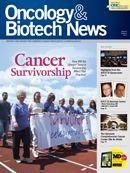Intensive Chemotherapy Boosts Prognosis in Older Teens With Acute Lymphoblastic Leukemia
New data demonstrate that older adolescents with acute lymphoblastic leukemia (ALL) can be cured using risk-adjusted intensive chemotherapy without prophylactic cranial irradiation or routine stem cell transplantation.
New data demonstrate that older adolescents with acute lymphoblastic leukemia (ALL) can be cured using risk-adjusted intensive chemotherapy without prophylactic cranial irradiation or routine stem cell transplantation.
The regimen credited with the high cure rate was used in Total Therapy Study XV and included intensive dexamethasone, vincristine, and asparaginase, as well as early triple intrathecal therapy for higherrisk ALL, all of which have been associated with improved outcomes in teenagers and young adults with ALL.
Importantly, treatment intensity was guided by risk stratification based on minimal residual disease (MRD) findings, which enables the precise identification of patients with a poor initial treatment response who might not have been identified by standard morphologic bone examination.
Ching-Hon Pui, MD, and associates said that their results are on a par with the best reported outcomes for younger children.
Historically, older adolescents with ALL have had a markedly worse prognosis than younger patients, the investigators said. Reasons include an increased prevalence of high-risk leukemia subtypes coupled with lower tolerance and adherence to therapy.
Research has shown consistently better outcomes for older adolescents with ALL who are treated in pediatric rather than adult clinical trials. The investigators note that this may be a function of the more intensive treatment, as well as stricter compliance due to parental involvement in the pediatric trials.
Pui and colleagues reviewed the outcomes of older adolescents (ranging from 15 to 18 years of age) who were treated in 4 consecutive Total Therapy studies between 1991 and 2007. In studies XIIIA, XIIIB, and XIV enrolling a total of 44 older and 421 younger patients, treatment selection was based on presenting clinical features and leukemic cell genetics.
In study XV, 45 older adolescents and 453 younger patients underwent risk-directed intensive chemotherapy.
Results showed that older teens enrolled in the 3 earlier studies had a 5-year, event-free survival rate of 59.1% and a 5-year overall survival rate of 59.1%, dramatically lower than the corresponding 82.6% (P <.001) and 88.3% (P <.001) rates occurring in the younger teens enrolled in the same studies.
In study XV, 5-year, event-free survival rates were 86.4% ± 5.2% for the older adolescents and 87.4% ± 1.7% for the younger patients. Overall survival rates were 87.9% ± 5.1% and 94.1% ± 1.2%, respectively.
The improved prognosis for older teenagers treated in study XV occurred without a noteworthy hike in toxicity. In fact, younger and older patients had similar cumulative rates of seizures, disseminated fungal infections, and allergic reactions. Older patients were, however, more likely to develop severe infection, osteonecrosis, thrombosis, and hyperglycemia, which the investigators said may be partly attributable to slower clearance of dexamethasone in this age group.
In addition, no patient in study XV developed central nervous system relapse even though prophylactic cranial irradiation was excluded from the protocol.
In study XV, older adolescents tended to require transplantation for poor early response more often than younger patients. Five of 6 older adolescents who underwent transplantation remain in first remission.
Pui and colleagues noted that their findings demonstrate that use of the Total Therapy Study XV treatment approach “abolished” the unfavorable prognostic impact of older age in childhood ALL. What’s more, given that 3 deaths from infection were responsible for half of the failures that occurred in older patients, the investigators maintain that the impressive cure rate in older adolescents may be even higher with increased vigilance in supportive care.
Finally, they said that the protocol should be evaluated in young adults with ALL.




